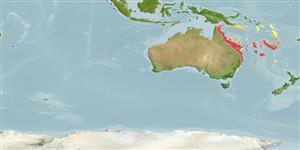Common names from other countries
Teleostei (teleosts) >
Eupercaria/misc (Various families in series Eupercaria) >
Lutjanidae (Snappers) > Lutjaninae
Etymology: Lutjanus: Malay, ikan lutjan, name of a fish.
More on author: Castelnau.
Environment: milieu / climate zone / depth range / distribution range
Ecology
Marine; reef-associated; depth range ? - 20 m (Ref. 9710). Subtropical; 10°S - 37°S, 143°E - 170°E (Ref. 55)
Western Pacific: restricted to the east coast of Australia and New Caledonia. The main Australian distribution is off southern Queensland between Cape Moreton (about 27°S) and the Capricorn Group(23°S). This species has been usually referred to as Lutjanus amabilis by previous authors.
Length at first maturity / Size / Weight / Age
Maturity: Lm 25.0, range 20 - 30 cm
Max length : 50.0 cm TL male/unsexed; (Ref. 55); common length : 30.0 cm TL male/unsexed; (Ref. 55); max. reported age: 40 years (Ref. 2290)
Dorsal spines (total): 10; Dorsal soft rays (total): 14; Anal spines: 3; Anal soft rays: 8. Snout somewhat pointed. Preopercular notch and knob moderately well developed. Scale rows on back rising obliquely above lateral line. Generally pale blue-gray to whitish with suffusion of yellow on upper back. A prominent golden brown stripe, slightly narrower than the eye, runs laterally from the rear edge of the of the opercle to the caudal peduncle.
Adults mainly inhabit coral reefs. Sometimes forming large aggregations around rocky outcrops during daylight hours. They disperse to feed at night (Ref. 9710). Usually marketed fresh.
Life cycle and mating behavior
Maturities | Reproduction | Spawnings | Egg(s) | Fecundities | Larvae
Allen, G.R., 1985. FAO Species Catalogue. Vol. 6. Snappers of the world. An annotated and illustrated catalogue of lutjanid species known to date. FAO Fish. Synop. 125(6):208 p. Rome: FAO. (Ref. 55)
IUCN Red List Status (Ref. 130435)
CITES (Ref. 128078)
Not Evaluated
Threat to humans
Harmless
Human uses
Fisheries: minor commercial; gamefish: yes
Tools
Special reports
Download XML
Internet sources
Estimates based on models
Preferred temperature (Ref.
115969): 23.3 - 27.9, mean 25.9 (based on 303 cells).
Phylogenetic diversity index (Ref.
82804): PD
50 = 0.5000 [Uniqueness, from 0.5 = low to 2.0 = high].
Bayesian length-weight: a=0.01413 (0.00930 - 0.02146), b=3.02 (2.90 - 3.14), in cm Total Length, based on LWR estimates for this species & Genus-body shape (Ref.
93245).
Trophic level (Ref.
69278): 3.7 ±0.0 se; based on diet studies.
Resilience (Ref.
120179): Medium, minimum population doubling time 1.4 - 4.4 years (K=0.26-0.34; tmax=40).
Fishing Vulnerability (Ref.
59153): Moderate vulnerability (38 of 100).
